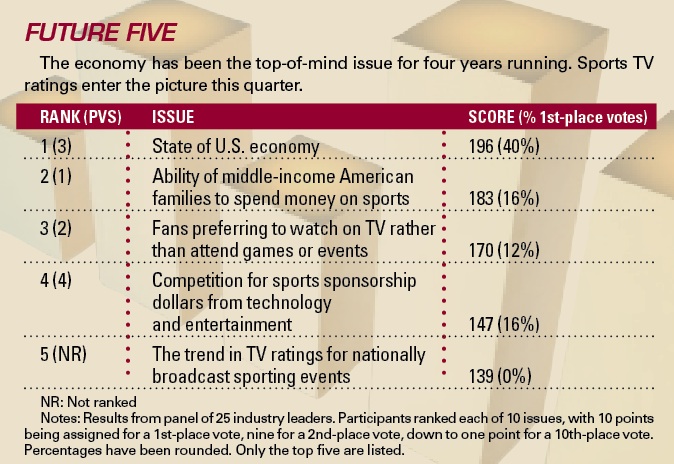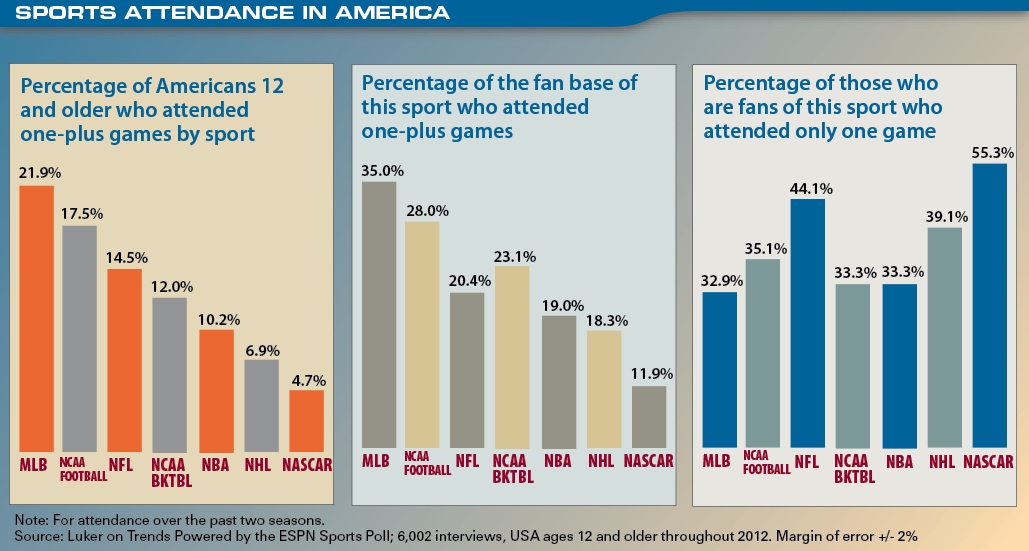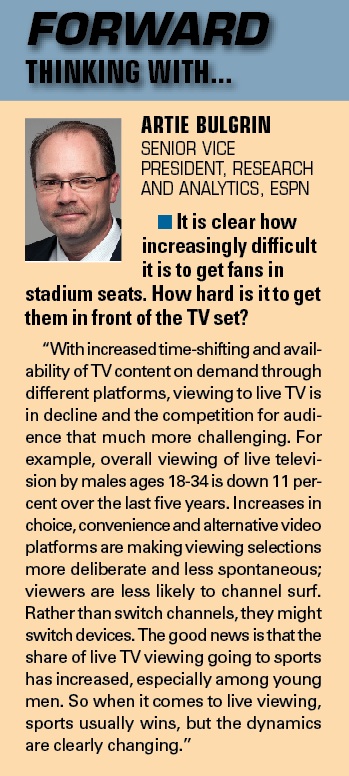We are accustomed to seeing attendance and TV ratings reports. From them we can see how sports fan behaviors are growing or declining in terms of TV audiences or attendance. But when was the last time you saw or even thought about what leads to a fan attending or watching a game in the first place?
Someone asked me how a sport can claim a hundred million fans when only a million attend games or a few million watch the games on TV. Good question. We somehow expect every fan of a sport to engage in every game. Not true, not likely, maybe nearly impossible.
To illustrate, consider this: Do you have a restaurant you eat at more than any other? We included questions on the ESPN Sports Poll in March to compare eating out with sports behavior. Forty-five percent of Americans said they have a restaurant they eat at most often, and 53 percent said they don’t. Do you? Is the restaurant where you eat most often also your favorite restaurant? Of the 45 percent who had a restaurant where they ate most often restaurant, 73 percent said it was also their favorite restaurant.
 |
In other words, only one in three Americans has a restaurant where they eat most often that is their favorite restaurant. Additionally, they only eat at that restaurant 2.5 times a month. Restaurant owners should be nervous now. To fill one seat, one time, every night, would take 12 people who say that restaurant is their favorite and where they eat most often — a 12-to-1 ratio of their very best customers. Can you imagine how many more people need to know about, like, and consider that restaurant just to fill one seat on a given night?
Now think of your very favorite sporting event. Mine is the Masters. How often do you consume 100 percent of that event? Every year I try to block off the entire weekend. In more than 30 years of trying, I have never seen even one round of the Masters in its entirety let alone all four. And the Masters is my favorite. Do you do any better? So imagine how it drops off from there. And think of how many bodies have to know about, like, and consider watching or attending a game or event in order to produce one person who actually does. One hundred million fans may never be enough.
There are even greater implications to us in the sports industry. Most of our business starts with (or assumes) the fan is already at the game or in front of the screen. How much effort goes into getting them there in the first place? From full-year 2012 ESPN Sports Poll data, the average American sports fan watches more than six hours (6:13) of sports on TV a week. Those who attend games watch an average of eight hours (8:08) of sports on TV weekly compared with 4.5 hours (4:32) for those who don’t attend.
American sports fans who prefer attending over watching on TV attend more — and actually watch more — than those who prefer to watch on TV. Sixty-five percent of those who said they prefer to attend went to an event in the last two seasons compared with 36 percent of those who prefer to watch on TV. Those who prefer to attend watch more than seven hours of sports a week (7:15), or 1.5 hours more than those who prefer watching over attending (5:45). So attending fuels viewing.
The chart shows how few people are actually accounting for most of the sports attendance in America. Fewer than 25 percent of Americans (ages 12 and older) attended a game in the last two seasons for any sport. Among those who did attend, one-third (MLB) to 55 percent (NASCAR) only attended once.
We ask people to rate the priority of free time options on a scale of 0-10. More than 80 percent say time with family is a top priority (8-10 on the scale), more than 40 percent say friends, but only 16 percent say sports fan behavior is a top priority. And attending is becoming a lower priority to watching sports on a screen.
Think of your own sports behavior, particularly when it is not associated with your work. How much of a priority is it to you? What have you seen from the sports industry to encourage you to do more? What are you doing with your business efforts to encourage fans to attend and watch more? Can we assume fans will continue to attend and watch — will continue to be fans — if we don’t do more to promote the options?
Here is the punch line. The sports industry is rightly investing time and money to build the media side of sports consumption. But media consumption is the end game, not the entry ticket. There is a clear path to being an avid fan of a sport: Know about it, play it, attend it, consume it in all its forms. All of these elements happen more powerfully when they are integrated with family/friend activity. The priority and time given to sports increases as it becomes more about time with family and friends. As the data shows, attending is a key driver of greater sports media consumption — and virtually no one goes to a game alone.

Rich Luker (rich@lukerco.com) is the founder of Luker on Trends and the ESPN Sports Poll.







